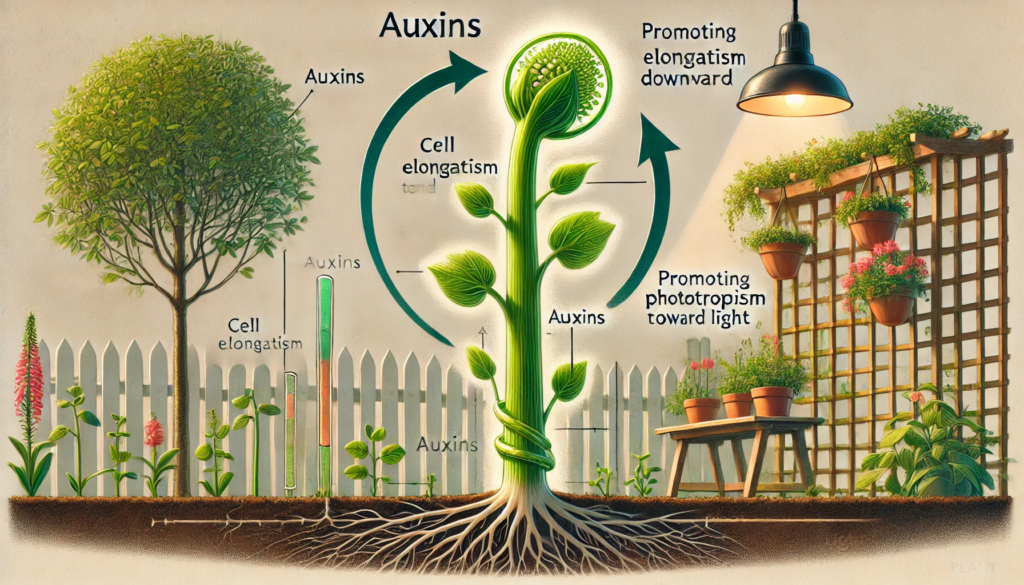Auxins are a class of plant hormones that play a critical role in regulating growth and development. These hormones are primarily responsible for controlling processes like cell elongation, root growth, and responses to light and gravity. This guide explores the role of auxins in plant growth, highlighting how they influence various aspects of plant development.
What are Auxins?
Auxins are naturally occurring plant hormones that regulate numerous growth processes. The most well-known auxin is indole-3-acetic acid (IAA), which is produced mainly in the shoot apices (the tips of stems) and young leaves. Auxins are transported from the shoot tips downward through the plant, influencing growth patterns and developmental responses.
Functions of Auxins:
- Stimulate cell elongation in stems and roots.
- Regulate phototropism (growth toward light) and gravitropism (growth in response to gravity).
- Promote root initiation and branching.
- Inhibit the growth of lateral buds, a phenomenon known as apical dominance.
- Assist in the formation of fruit and flowering.
How Auxins Affect Plant Growth
1. Cell Elongation
Auxins promote cell elongation by loosening the plant cell walls, allowing cells to expand. In stems, auxins accumulate on the shaded side of the plant, causing cells to elongate more on that side. This uneven growth leads to the characteristic bending of plants toward light, known as phototropism.
Mechanism:
- Auxins stimulate the activity of proton pumps in cell membranes, increasing the acidity of the cell wall.
- The acidic environment activates expansins, enzymes that loosen the cell wall.
- This loosening allows water to enter the cell, causing it to expand and elongate.
2. Phototropism
Phototropism is the directional growth of a plant in response to light. Auxins play a central role in this process by redistributing themselves to the side of the plant that is shaded, away from the light source.
How Phototropism Works:
- When a plant is exposed to light from one direction, auxins move to the darker side of the stem.
- The higher concentration of auxins on the shaded side causes the cells there to elongate more than those on the light-exposed side.
- As a result, the plant bends toward the light, optimizing its exposure for photosynthesis.
3. Gravitropism
Gravitropism (or geotropism) refers to a plant’s ability to sense and respond to gravity. Auxins help guide the growth of roots downward and stems upward by responding to gravitational signals.
How Gravitropism Works:
- In the roots, auxins accumulate on the lower side, inhibiting cell elongation in that area and causing the root to bend downward.
- In stems, auxins also collect on the lower side, but here they promote cell elongation, causing the stem to grow upward.
4. Apical Dominance
Auxins produced in the shoot tip suppress the growth of lateral (side) buds, a phenomenon known as apical dominance. This ensures that the plant grows vertically rather than branching out too soon, allowing it to maximize access to light.
Mechanism:
- As long as the shoot tip is intact and producing auxins, the growth of lateral buds is inhibited.
- If the shoot tip is removed, the source of auxins is eliminated, and the lateral buds begin to grow, leading to a bushier plant.
5. Root Development
Auxins also play a crucial role in root initiation and growth. They promote the formation of lateral roots and adventitious roots, helping the plant to anchor itself and absorb water and nutrients more efficiently.
Uses in Horticulture:
- Auxins are often used in rooting hormones to stimulate root growth in cuttings. Gardeners and horticulturists apply synthetic auxins, such as indole-3-butyric acid (IBA), to encourage root development in plant propagation.
Auxins in Plant Development
In addition to influencing growth patterns, auxins are involved in several key developmental processes.
1. Fruit Development
Auxins are involved in the formation and growth of fruits. In many plants, auxins are produced in the developing seeds, stimulating the surrounding fruit tissue to grow. In some cases, applying synthetic auxins can stimulate fruit development without fertilization, leading to parthenocarpic fruits (seedless fruits).
2. Leaf and Flower Formation
Auxins also regulate the growth and arrangement of leaves and flowers. By controlling the rate of cell division and elongation, auxins influence the positioning of new leaves and flowers, a process known as phyllotaxis.
Conclusion
Auxins are essential plant hormones that regulate a wide range of growth and developmental processes, from cell elongation and root formation to phototropism and apical dominance. By understanding the role of auxins, gardeners and horticulturists can better manipulate plant growth, improve yields, and promote healthier plants. Whether you’re encouraging root growth in cuttings or ensuring optimal light exposure through phototropism, auxins are at the heart of plant growth and development.
FAQ
How do auxins cause plants to bend toward light?
Auxins redistribute to the shaded side of the plant, causing those cells to elongate more than the cells on the light-exposed side. This uneven growth causes the plant to bend toward the light.
What is the role of auxins in root development?
Auxins promote the growth of lateral and adventitious roots. Synthetic auxins are often used in rooting hormones to encourage root development in plant cuttings.
What is apical dominance?
Apical dominance is the suppression of lateral bud growth by auxins produced in the shoot tip. This ensures that the plant grows vertically until the tip is removed, after which lateral buds can develop.
Can auxins be used to create seedless fruits?
Yes, applying synthetic auxins can stimulate fruit development without fertilization, resulting in seedless fruits, known as parthenocarpic fruits.
How do auxins influence gravitropism in plants?
In roots, auxins accumulate on the lower side in response to gravity, inhibiting cell elongation and causing the root to grow downward. In stems, auxins promote cell elongation on the lower side, causing the stem to grow upward.



